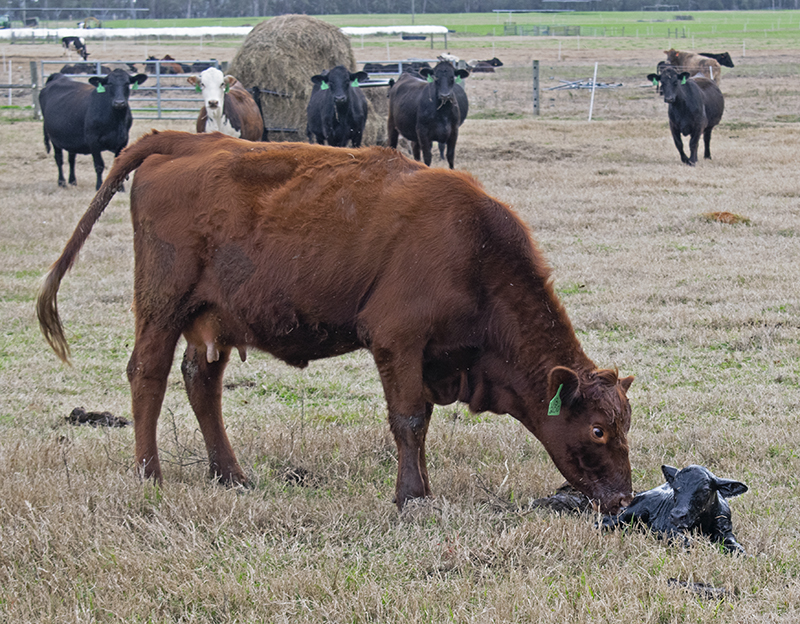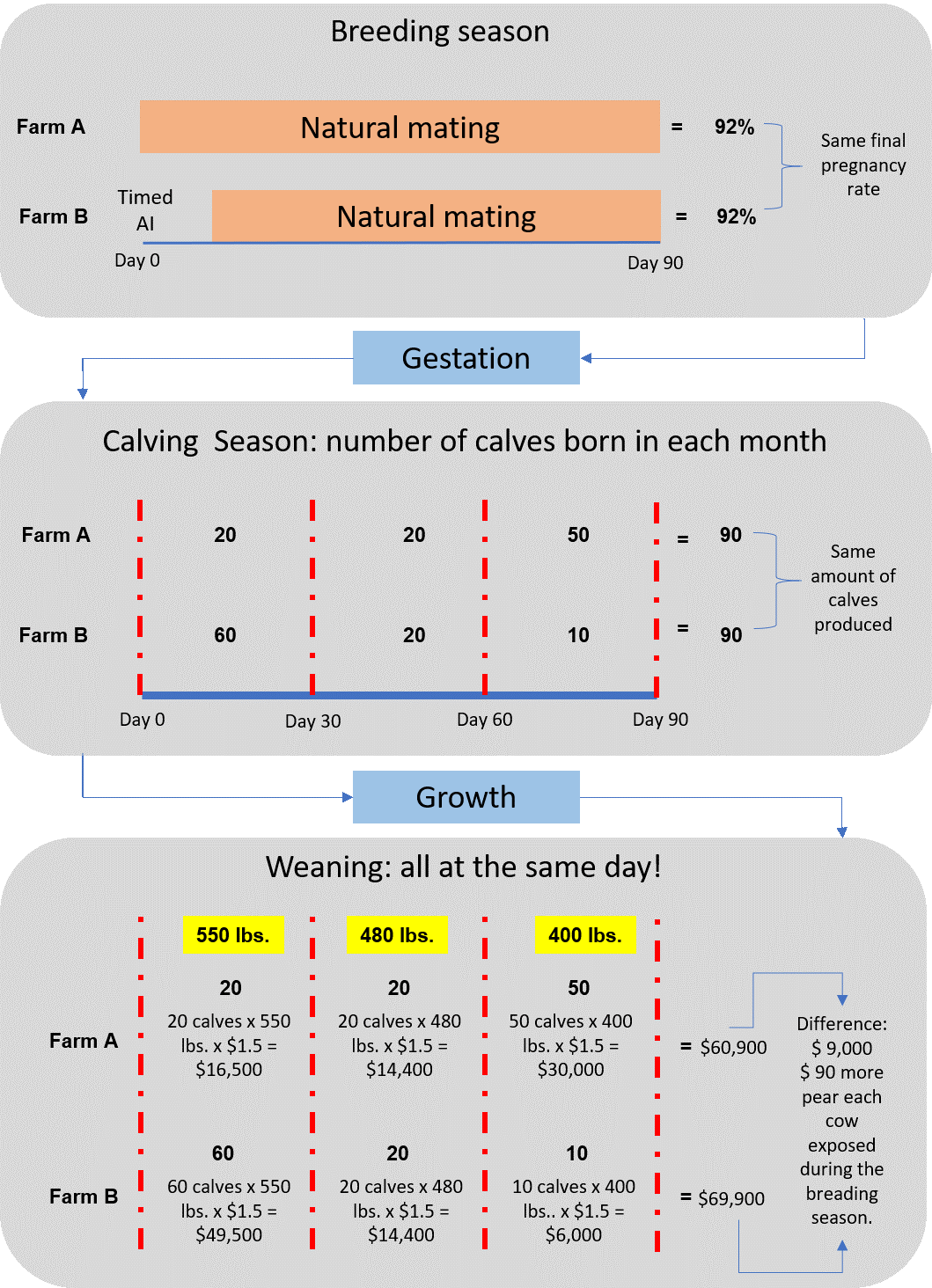
Heifer calves born early in the calving season are generally produced by the most fertile cattle, and if they are kept as replacements, will likely be the most productive females in your herd their whole lives. The steer calves born early in the season tend to be heaviest and most profitable to sell at weaning. Photo credit: Doug Mayo, UF/IFAS
Angela Gonella Diaza, UF/IFAS Cattle Reproduction Specialist
Estrus synchronization is a technology that can improve the efficiency of the beef cattle industry. Estrus synchronization allows optimal use of artificial insemination (AI), and the utilization of the genetics of the elite bulls of a breed. The type of top-end bulls that would be impractical for a commercial producer to purchase. Also, because of the use of exogenous hormones, this kind of program will allow most (or a good proportion) of the females to become pregnant in the first 30 days of the breeding season. This is especially important when cows are not all cycling at the beginning of the breeding season. Because, exposure to progesterone can help to “jump start” estrus in non-cycling cows.
And why is this important? Because this dramatically modifies the calving distribution of a beef herd. As you may know, the time when your calves are born has tremendous impact on their productive life. Calves should be born when the best conditions (climate, forages availability, etc.) are offered for them and their mothers. Also, the calves born early in the calving season will have more time to grow before weaning, compared to calves born near the end of the season.
Calving early is not only good for the calf, but it is also good for the cow. A cow that calves at the beginning of the season will have more time to recover from giving birth and to start cycling again to be bred for next year’s calf. If the timing is set correctly, she should have access to the best forages at the time when she has the greatest nutritional requirements. When the majority of the calves are born in the first 30-45 days, it becomes much easier to manage your nutritional program.
To understand how the calving distribution could affect your income, lets look at an example. Let’s say that we have 2 farms. Both farms have the same size herd (100 cows) and produce the same number of calves in the calf crop (90 calves). You might think that, if the market price was the same ($1.50 per pound) the income of the two farms would be about the same. However, if the calving distribution is not the same, the income of the two farms will be different.
In this example, farm A has a natural mating program. They put the bulls in with the cows for a 90 day breading season. For farm B, the reproductive program consists of one timed-AI (TAI) on the first day of the season, and then use of cleanup bulls for natural service. In the figure below, you can see how the calving distribution impacts income, when all of the calves are weaned and sold at the same time.
–
For Farm A: 20, 20, and 50 calves were born in the first, second, and third month of the calving season, respectively. Believe it or not, this is a typical calving distribution for many farms with natural service.
On the other hand, for Farm B: 60, 20, and 10, calves were born in the first, second, and third months of the calving season, respectively. Form the births of the first month, 40 calves were produced by the TAI and 20 by the cleanup bulls. As you can see, the cows in both herds were efficient, since 90% of them produced a calf.
But again, the calves were not born at the same time. At weaning, calves that were born in the first, second and, third month will have an average weight of 550, 480, and 400 lbs., respectively. Of course, because the TAI protocol changes the calving distribution, most of the calves of Farm B were born in the first month of the calving season. While in farm A, most of the calves were born in the last month. This has a tremendous impact on income.
Let’s say that for both farms, the weaning date was the same (280 days of age), and that they market the calves at the same time and receive an average sale price of $1.50 / lb. This means that farm A receives a total of $60,900 for their calf crop. This total is represented by $16,500 of the calves born in the first month of the calving season, $14,400 for the calves born in the second month, and $30,000 for the calves born in the last month.
Now let’s look at the difference for farm B. Remember, farm B produces the same number of calves, but they receive $69,900 from the sale. From this total, $49,500 came from the calves that were born in the first month of the calving season, $14,400 form the calves that were born in the second month, and $6,000 from the calves that were born in the last month.
The difference in the income of Farm A and Farm B is $9,000; or $90 per cow exposed to the TAI protocol at the beginning of the breeding season. And, for this example, we didn’t consider the benefits that this manipulation of the calving distribution could have on the health and productivity of the cow! This simple example also does not account for the superior genetics from using A.I. sires in the first breeding, which should increase the weaning weights of the earliest calves even more.
By now you must be thinking, ok, one could increase income $90 per cow, but what about the cost? The implementation cost of a reproductive program (TAI, Estrus detection + AI, or Bull-synch) can vary between $20 to $35 per cow. This price varies in the relation to how many times you reuse the CIDR (intravaginal device), and the labor cost will depend on the number of cows enrolled into the program. This means that your profit could increase by ~$50 per cow.
I hope this article helps you to understand the importance of the calving distribution. Remember, the best way of manipulating your calving distribution is estrus synchronization! This synchronization could be combined with estrus detection and AI, with TAI, or simple synchronization and bull breading.
If you have any comments or questions, don’t hesitate to contact me. I would love to read your emails and talk to you about your ideas on how this concept might be implemented in your herd management!
- Heat Stress and its Impact on Cattle Reproduction - March 14, 2025
- Fall is Here.Time for Pregnancy Testing Cattle! - September 13, 2024
- How Stress Impacts Cattle Reproduction - March 15, 2024

